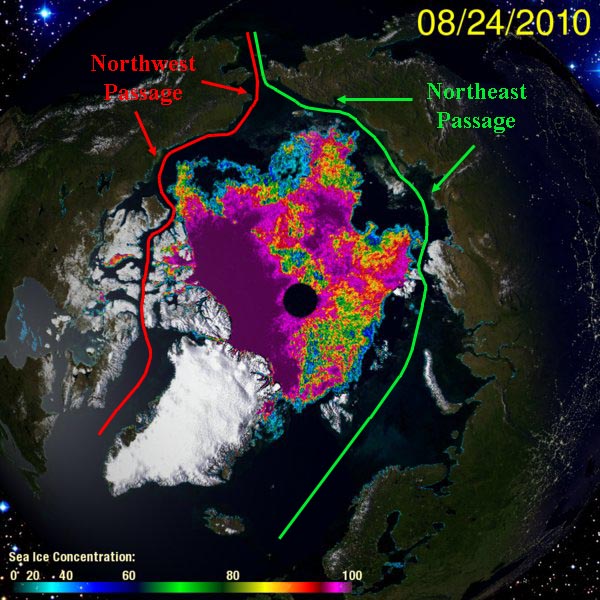
Arctic sea ice extent on August 24, 2010. Compiled by the University of Illinois Cryosphere Today.
The Northwest Passage is now open for business. And, as this satellite image composited by the The University of Illinois Cryosphere Today shows, the Northeast Passage is too. Jeff Masters at WunderBlog reports:
“It is now possible to completely circumnavigate the Arctic Ocean in ice-free waters, and this will probably be the case for at least a month. This year marks the third consecutive year—and the third time in recorded history—that both the Northwest Passage and Northeast Passage have melted free. The Northeast Passage opened for the first time in recorded history in 2005 and the Northwest Passage in 2007. It now appears that the opening of one or both of these northern passages is the new norm, and business interests are taking note—commercial shipping in the Arctic is on the increase, and there is increasing interest in oil drilling.”
The National Snow and Ice Data Center says this year’s early clearing of sea ice likely results from record warm temperatures this past spring over the Western Canadian Arctic, as well as from an ongoing decline in older multiyear ice—once a hallmark of the Arctic, now seriously threatened. Spring 2010 was the warmest in the region since 1948, with some parts of the Western Canadian Arctic heating to more than 6°C/11°F above normal.
Meanwhile, sea ice around Antarctica is at a record high, which some mistakenly take as proof that global warming isn’t real. In fact growing Antarctic sea ice is at least in part a result of a warming ocean, as SkepticalScience explains:
“The Southern Ocean consists of a layer of cold water near the surface and a layer of warmer water below. Water from the warmer layer rises up to the surface, melting sea ice. However, as air temperatures warm, the amount of rain and snowfall also increases. This freshens the surface waters, leading to a surface layer less dense than the saltier, warmer water below. The layers become more stratified and mix less. Less heat is transported upwards from the deeper, warmer layer. Hence less sea ice is melted.”















